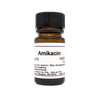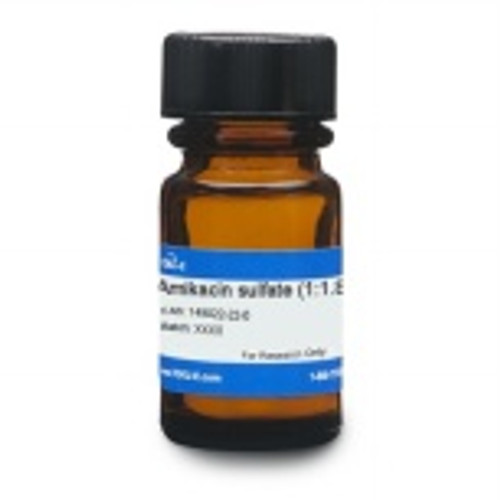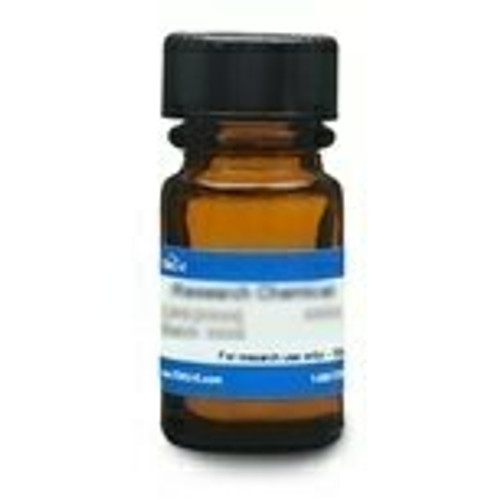Amikacin is semi-synthetic, broad-spectrum aminoglycoside antibiotic derived from its counterpart, Kanamycin A. Amikacin was patented in 1971 and came into commercial use in 1976. The presence of the amino-hydroxy-butyryl group prevents enzymatic modification of Amikacin at multiple positions. This renders Amikacin a more effective decontaminating agent, as microorganisms which develop resistance to other aminoglycosides remain susceptible to Amikacin. This also gives Amikacin a broader spectrum than the other aminoglycosides currently in use. Amikacin is one of the most common aminoglycosides in veterinary research. It is also commonly used in antimicrobial susceptibility testing.
Amikacin is freely soluble in water.
We also offer:
| Mechanism of Action | Amikacin binds to the 30S ribosomal subunit (16S rRNA and S12 protein) resulting in interference with the translational initiation complex and mRNA misreading, which leads to a faulty or nonexistent protein. |
| Spectrum | Amikacin is active against Gram-negative and Gram-positive bacteria. Mycobacterium tuberculosis is also susceptible to Amikacin. |
| Microbiology Applications | Amikacin is commonly used in clinical in vitro microbiological antimicrobial susceptibility tests (panels, discs, and MIC strips) and rapid antimicrobial testing platforms. Medical microbiologists use this information to recommend antibiotic treatment options. Samples of microbes grown in presence of a 30 µg Amikacin discs with a zone of inhibition of <14 mm in diameter are considered resistant. Intermediate resistance zones of inhibition are typically 15 mm-16 mm in diameter. Representative MIC values include:
|
| Eukaryotic Cell Culture Applications | Amikacin demonstrates lysosomal phospholipidosis in vitro, with the compound binding to the phospholipid bilayer.
An LC–MS/MS assay was developed to quantify Amikacin in different biological matrices. This technology can facilitate future studies on improving Amikacin-associated nephrotoxicity. It would be useful for in vitro studies characterizing Amikacin uptake kinetics in renal cells, and in vivo pharmacokinetic studies (Chan et al, 2020). Contamination of cell cultures for virus isolation is problematic. Amikacin (and vancomycin) were chosen to replace the penicillin and gentamicin used conventionally. This combination was not toxic to cell cultures remained stable in media for over six months. Virus isolation rate was maintained and contamination was reduced from 10% to 1.5%. This combination can be used for maintenance and transport media to control the emerging problem of viral culture contamination (Lo et el, 1996). |
| Molecular Formula | C22H43N5O13 |
| References |
Chan K, Wang W , Ledesma KR, Yin T, and Tam VH (2020) A robust LC–MS/MS method for Amikacin: Application to cellular uptake and pharmacokinetic studies. Bioanalysis 12(7):445-454 PMID 32343148 Christophe T et al (2009) High content screening identifies decaprenyl-phosphoribose 2’ epimerase as a target for intracellular antimycobacterial inhibitors. PLoS Pathog. 5(10): e10000645. PMID 19876393 Davis, BD (1987) Mechanism of bactericidal action of aminoglycosides. Microbiol Rev 51 (3 ): 341-50 PMID 3312985 Dudek M, Romanowska J, Witula T, Trylska J (2014) Interactions of Amikacin with the RNA model of the ribosomal A-site: Computational, spectroscopic and calorimetric studies. Biochimie 102:188-202. PMID 24769038 Laurent G, Carlier MB, Rollman B, Van Hoof F, Tulkens P (1982) Mechanism of aminoglycoside-induced lysosomal phospholipidosis: In vitro and in vivo studies with gentamicin and Amikacin. Biochem. Pharmacol 31(23):3861-70. PMID 7159463 Lo JY, Lim WW, Tam BK, Lai MY (1996) Vancomycin and Amikacin in cell cultures for virus isolation. Pathology. 1996;28(4):366-369 PMID 9007960 Singh R, Ray P, Das A, Sharma MJ (2009) Role of persisters and small-colony variants in antibiotic resistance of planktonic and biofilm-associated Staphylococcus aureus: An in vitro study. Med. Microbiol 58(8):1067-1073 PMID 1952816 Amikacin (TOKU-E)Parastoo S, Ahya A-A, Soudi MR, Gamazo C and Irache JM (2016) Amikacin loaded PLGA nanoparticles against Pseudomonas aeruginosa. E. J. Pharm. Sci 93:392-398 PMID 27575877 |
| MIC | Bacillus subtilis| <100|| Borrelia burgdorferi S.L.| 32 - >128|| Brucella| 1 - 4|| Burkholderia cepacia| 32 - >64|| Candida albicans| <100|| Citrobacter amalonaticus| ≤0.25 - 32|| Citrobacter braakii| ≤0.25 - 32|| Citrobacter diversus| ≤0.25 - 32|| Citrobacter farmeri| ≤0.25 - 32|| Citrobacter freundii| ≤0.25 - 32|| Citrobacter koseri| ≤0.25 - 32|| Citrobacter spp.| ≤0.25 - 32|| Diplococcus pneumoniae| 50 - 200|| Enterobacter aerogenes| ≤0.25 - >32|| Enterobacter agglomerans| 1 - 8|| Enterobacter amnigenus| ≤0.25 - >32|| Enterobacter asburiae| ≤0.25 - >32|| Enterobacter cancerogenus| ≤0.25 - >32|| Enterobacter cloacae| ≤0.25 - >128|| Enterobacter cloacae (4073)| 1|| Enterobacter cloacae (5420)| 1|| Enterobacter cloacae (ATCC 3047)| 4|| Enterobacter gergoviae| ≤0.25 - >32|| Enterobacter hormaechei| ≤0.25 - >32|| Enterobacter intermedius| 0.25 - >32|| Enterobacter sakazakii| ≤0.25 - >32|| Enterobacter spp.| ≤0.25 - >32|| Enterobacter taylorae| ≤0.25 - >32|| Enterobacteriaceae| 0.03 - 128|| Enterococcus faecalis| 128|| Erwinia carotovora| <100|| Escherichia coli| ≤0.25 - 64|| Escherichia coli (5401)| 2|| Escherichia coli (5411)| 8|| Escherichia coli (ATCC 25922 + aminoglycoside-susceptible)| 1|| Escherichia coli (ATCC 25922)| 3.9 - 64|| Escherichia coli (ESBL)| <0.25 - 128|| Escherichia coli (JM83 + AAC6'/APH2'')| 8|| Escherichia coli (JM83 + APH(3')-I)| 1|| Escherichia coli (JM83)| 1|| Escherichia coli (NCTC 10418)| 0.5|| Escherichia coli (non-ESBL)| ≤0.5 - 16|| Escherichia coli (non-ESBL)| 2 - 4|| Escherichia coli (SHV-producing)| <0.25 - 8|| Haemolytic streptococci| 1 - 128|| Haemophilus influenzae| 1.6 - 6.3|| Haemophilus spp.| 0.12 - 16|| Klebsiella ornithinolytica| ≤0.25 - >32|| Klebsiella ozaenae| ≤0.25 - >32|| Klebsiella pneumonia| ≤0.25 - >64|| Klebsiella pneumonia (5427)| 2|| Klebsiella pneumonia (5436)| 1|| Klebsiella pneumonia (ESBL)| ≤0.5 - >256|| Klebsiella pneumonia (non-ESBL)| ≤0.5 - 32|| Klebsiella pneumoniae (ATCC 13883 + aminoglycoside-susceptible)| 1|| Klebsiella pneumoniae (ATCC 33018)| 128|| Klebsiella pneumoniae (ATCC 700603 + ampicillin-resistant)| 0.5 - 1|| Klebsiella spp.| ≤0.25 - >32|| Klebsiella spp. (ESBL)| ≤0.25 - >32|| Klebsiella terrigena| ≤0.25 - >32|| Morganella morganii| ≤1 - 8|| Morganella morganii (indole-positive)| 0.5 - 32|| Morganella spp.| ≤0.5 - 32|| Mycobacterium chelonae| 32|| Mycobacterium marinum| 0.5 - 8|| Mycobacterium tuberculosis (BACTEC 460 + H37Ra)| 2.5|| Mycobacterium tuberculosis (BACTEC 460 + H37Ragfp)| 2.5|| Mycobacterium tuberculosis (GFPMA H37Ragfp)| 2.5|| Mycobacterium tuberculosis (H37Ra)| 20|| Mycobacterium tuberculosis (H37Rv)| 0.5 - 20|| Neisseria spp.| 0.5 - 16|| Nocardia brasiliensis| 0.125 - 4|| Pandoraea apista| 16|| Pandoraea genomo| >64|| Pandoraea pnomenusa| >64|| Pasteurella multocida| 2 - 32|| Pasteurella multocida| <4|| Plesiomonas shigelloides| 2 - 32|| Pneumococci| 1 - 128|| Proteae spp. (indole-positive)| ≤0.25 - >32|| Proteus mirabilis| 0.5 - >32|| Proteus mirabilis| 1 - 8|| Proteus mirabilis| ≤1 - 8|| Proteus mirabilis (ESBL)| ≤0.5 - >256|| Proteus rettgeri (indole-positive)| 0.5 - 32|| Proteus vulgaris (indole-positive)| 0.5 - 32|| Providencia alcalifaciens (indole-positive)| 0.5 - 32|| Providencia spp.| ≤0.5 - 32|| Providencia stuartii (indole-positive)| 0.5 - 32|| Pseudomonas aeruginosa| ≤0.25 - 512|| Pseudomonas aeruginosa (1019)| 4|| Pseudomonas aeruginosa (1037)| 2|| Pseudomonas aeruginosa (66)| 4|| Pseudomonas aeruginosa (956)| 16|| Pseudomonas aeruginosa (ATCC 27853 + aminoglycoside-resistant)| 32 - 64|| Pseudomonas aeruginosa (ATCC 27853)| 1.9 - 2|| Pseudomonas aeruginosa (C43)| 32|| Pseudomonas aeruginosa (ciprofloxacin-resistant)| 16|| Pseudomonas aeruginosa (ciprofloxacin-susceptible)| 3|| Pseudomonas aeruginosa (clinical isolate)| ≤1 - >64|| Pseudomonas aeruginosa (NCTC 10662)| 2|| Pseudomonas cepacia| >128|| Pseudomonas spp.| 0.06 - 128|| Salmonella (group B)| ≤0.25 - 16|| Salmonella (group C)| ≤0.25 - 16|| Salmonella (group D)| ≤0.25 - 16|| Salmonella agona| ≤0.25 - 16|| Salmonella arizonae| ≤0.25 - 16|| Salmonella bareilly| ≤0.25 - 16|| Salmonella enterica| ≤0.25 - 16|| Salmonella enteritidis| ≤0.25 - 16|| Salmonella hadar| ≤0.25 - 16|| Salmonella heidelberg| ≤0.25 - 16|| Salmonella infantis| ≤0.25 - 16|| Salmonella litchfield| ≤0.25 - 16|| Salmonella Montevideo| ≤0.25 - 16|| Salmonella muenchen| ≤0.25 - 16|| Salmonella Newport| ≤0.25 - 16|| Salmonella panama| ≤0.25 - 16|| Salmonella Paratyphi| ≤0.25 - 16|| Salmonella schwarzengrund| ≤0.25 - 16|| Salmonella spp.| ≤0.25 - 16|| Salmonella stanley| ≤0.25 - 16|| Salmonella stpaul| ≤0.25 - 16|| Salmonella thompson| ≤0.25 - 16|| Salmonella typhi| ≤0.25 - 16|| Salmonella typhimurium| ≤0.25 - 16|| Salmonella virchow| ≤0.25 - 16|| Serratia fonticola| ≤0.25 - >32|| Serratia liquefaciens| ≤0.25 - >32|| Serratia marcescens| ≤0.25 - >32|| Serratia marcescens (ATCC 13880)| 8|| Serratia marcescens (SM-1178 + multidrug-resistant)| 32|| Serratia odorifera| ≤0.25 - >32|| Serratia plymuthica| ≤0.25 - >32|| Serratia rubidaea| ≤0.25 - >32|| Serratia spp.| ≤0.25 - >32|| Shigella boydii| 2 - 8|| Shigella dysenteriae| 2 - 8|| Shigella dysenteriae (SD-5 + multidrug-resistant)| 2 - ?|| Shigella flexneri| 0.5 - 16|| Shigella sonnei| 0.5 - 16|| Shigella spp.| 2 - 8|| Shingella dysenteriae| 0.5 - 16|| Staphylococci| 0.008 - 128|| Staphylococcus aureus| 2 - <100|| Staphylococcus aureus (1010 + methicillin-resistant)| 8|| Staphylococcus aureus (3)| <1|| Staphylococcus aureus (31593)| 1|| Staphylococcus aureus (ATCC 25923 + aminoglycoside-susceptible)| 1|| Staphylococcus aureus (ATCC 29213)| 1 - 2|| Staphylococcus aureus (ATCC 33591 + methicillin-resistant)| 8 - 16|| Staphylococcus aureus (ATCC 6571)| 1|| Staphylococcus aureus (methicillin-resistant)| 0.5 - 32|| Staphylococcus aureus (methicillin-susceptible)| 0.25 - 8|| Staphylococcus epidermidis (methicillin-resistant)| 0.5 - 32|| Staphylococcus epidermidis (methicillin-susceptible)| 0.25 - 8|| Staphylococcus haemolyticus (methicillin-resistant)| 0.25 - 32|| Staphylococcus intermedius (ATCC 29663)| 2|| Staphylococcus saprophyticus (methicillin-susceptible)| 0.25 - 8|| Stenotrophomonas maltophilia| 0.5 - >272|| Streptococcus faecalis| >64|| Xanthomonas campestris| <100|| Xanthomonas maltophilia| 48|| Yersinia enterocolitica| 2 - 32|| |






